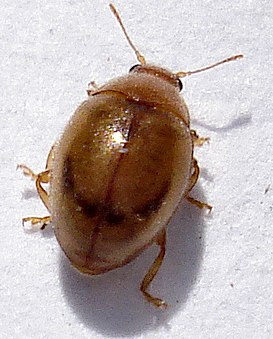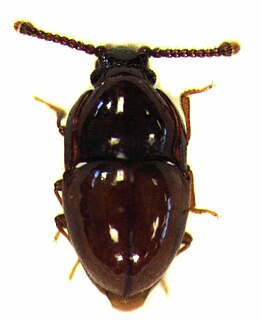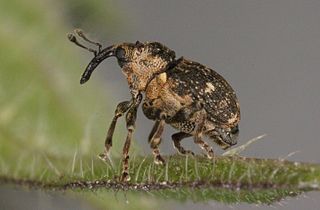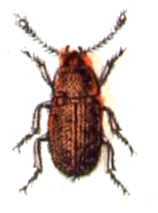
Harpalinae is a huge subfamily of ground beetles that contains 20,000 species or ~6,400 spp. in 24 tribes worldwide, according to others. A rarely used common name for the subfamily is the harp beetles. The Harpalinae contain the most apomorphic ground beetles, displaying a wide range of forms and behaviors. Some are, rare among ground beetles, omnivores or even herbivores.

Rhyzobius is a genus in the lady beetle family (Coccinellidae). It belongs to tribe Coccidulini of subfamily Coccidulinae, which is sometimes subsumed in the Coccinellinae as a tribe with the Coccidulini downranked to subtribe.

Cryptophagidae is a family of beetles with representatives found in all biogeographic realms. Members of this family are commonly called silken fungus beetles and both adults and larvae appear to feed exclusively on fungi although in a wide variety of habitats and situations, such as rotting wood and shed animal fur and feathers. These beetles vary from about 1 to 11 millimeters long, and usually have an oval body shape with a slight "waist".

Roeslerstammiidae is a family of insects in the order Lepidoptera. The family arose from the taxonomic uncertainty of the genus Roeslerstammia Zeller, 1839, which was assigned to different families. The genus Roeslerstammia was removed from the Yponomeutidae Stephens, 1829, and placed in the Amphitheridae Meyrick, 1913, which in consequence became a junior synonym of Roeslerstammiidae. Consequently, Roeslerstammiidae comprises the Palearctic genus Roeslerstammia, as well as the Oriental and Australasian genera that form part of the Amphitheridae.

Pytilia is a genus of small brightly coloured seed-eating birds in the family Estrildidae. They are distributed across Africa.

Coenophila is a genus of moths of the family Noctuidae.
Anisodactylus is a genus of ground beetle native to the Palearctic, the Near East and North Africa. It contains the following species:

Eupoecilia is a genus of moths belonging to the subfamily Tortricinae of the family Tortricidae. It was described by Stephens in 1829.
Alophia is a monotypic snout moth genus described by Émile Louis Ragonot in 1893. Its single species, Alophia combustella, was described by Gottlieb August Wilhelm Herrich-Schäffer in 1852. It is found in Spain, Portugal, France, Italy, Sardinia, Sicily, Greece, North Macedonia, Croatia, Hungary, Romania, Ukraine and southern Russia.

Staphylinini is a tribe of large rove beetles in the family Staphylinidae. There are at least 20 genera and 120 described species in Staphylinini.
Goeridae is a family of caddisflies in the order Trichoptera. There are about 12 genera and at least 160 described species in Goeridae.

Cercyon is a genus of water scavenger beetles in the family Hydrophilidae. There are at least 50 described species in Cercyon.

Rhinusa is a genus of true weevils in the family of beetles known as Curculionidae. There are at least 20 described species in Rhinusa.

Nedyus is a genus of minute seed weevils in the beetle family Curculionidae. There are more than 50 described species in Nedyus.

Typhaea is a genus of beetles belonging to the family Mycetophagidae.

Acidota is a genus of beetles belonging to the family Staphylinidae.
Agramma is a genus of insects belonging to the family Tingidae.
Bisnius scoticus is a species of beetle belonging to the family Staphylinidae.

Chaetopteryx is a genus of insects belonging to the family Limnephilidae.

Heterothops is a genus of beetles belonging to the family Staphylinidae.














